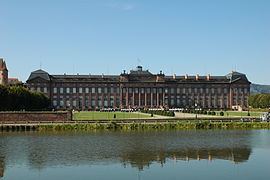Department Bas-Rhin Canton Saverne Local time Thursday 1:55 PM | Arrondissement Saverne Area 26.01 km² | |
 | ||
Intercommunality Communauté de communes de la région de Saverne Weather 15°C, Wind NE at 18 km/h, 58% Humidity Points of interest Rohan Castle, Château de Hohbarr, Col de Saverne, Oberhof, La Roseraie | ||
Saverne (French: Saverne, [savɛʁn]; Alsatian: Zàwere [ˈd̥sɐːvəʁə]; (German: Zabern )) is a commune in the Bas-Rhin department in Grand Est in north-eastern France. It is situated on the Rhine-Marne canal at the foot of a pass over the Vosges Mountains, and 45 km (27 mi) N.W. of Strasbourg.
Contents
Map of 67700 Saverne, France
In 2006, Saverne had a total population of 11,907, and its metropolitan area, of 17,482.
History
Saverne (Tres Tabernae Cesaris (Caesar's three taverns, so called because in the older days there were three taverns on the way to the Lorraine plateau where they would change oxen due to the steep incline) was an important place in the time of the Roman Empire, and, after being destroyed by the Alamanni, was rebuilt by the emperor Julian.
During the German Peasants' War the town was occupied, in 1525, by the insurgents, who were driven out in their turn by Duke Anton of Lorraine. It suffered much from the ravages of the Thirty Years' War, but the episcopal palace, then destroyed, was subsequently rebuilt, and in 1852 was converted by Louis Napoleon into a place of residence for widows of knights of the Legion of Honour.
Saverne was conquered by Imperial Germany after the Franco-Prussian War. It was returned to French control after World War I.
In 1913, the city was the theater of the infamous "Saverne Affair". This event gave rise to the term Zabernism (from the German name of the town), meaning abuse of military authority, or unwarranted aggression.
Sights
The emblem of the town is a unicorn. Legend has it that a unicorn's horn was found in one of the nearby castles in ruins. It is more likely that a narwhal's tooth was discovered and mistaken for a unicorn's horn. However, it gave its name to the local beer (fr: Bière de la Licorne) and to the Karlsbräu brewery (f: Brasserie la Licorne) making it.
Its principal building, the Rohan Castle (Château des Rohan), is the former residence of the bishops of Strasbourg, rebuilt by Cardinal de Rohan in 1779, it was used by the Germans as barracks. It now houses the city museum with its large archeological collection of Roman and Celtic artifacts, a hostel, a small arts and crafts museum as well as the collection of 20th century and ethnological art donated by feminist journalist and politician Louise Weiss.
Other sights include the 15th century former castle (Château vieux) and the adjacent 15th century Roman Catholic parish church of Notre-Dame-de-la-Nativité with fine stained glass and sculptures; a Gothic former Franciscan, then Récollets, monastery with a church and a cloister ornated by 17th-century frescoes; as well as several old houses, among which the heavily decorated Maison Katz stands out.
In the vicinity are the ruined castles of Haut-Barr, Grand Geroldseck, Ochsenstein and Greifenstein. Hence a beautiful road, immortalized by Goethe in Dichtung und Wahrheit, leads across the Vosges to Pfalzburg. The mountain pass (Col de Saverne) contains a vast botanical garden, the Jardin botanique du col de Saverne.
Saverne is also known for its famous Rose Garden, locally known as La roseraie. It is also the host of the International Contest of New Roses every year. The Garden itself blesses visitors with over 550 varieties of roses.[1]
An old semaphore tower, relief of the former Landau (and later Strasbourg) to Paris semaphore line, can be seen in the vicinity. It was one of the 50 stations built by the first French Empire on this line which was the second of this kind in France.
Notable people
Geography
Neighboring communes: Altenheim - Dettwiller - Eckartswiller - Ernolsheim-lès-Saverne - Friedolsheim – Furchhausen – Gottenhouse – Gottesheim – Haegen – Hattmatt – Landersheim – Lupstein– Maennolsheim – Monswiller – Ottersthal – Otterswiller – Printzheim – Reinhardsmunster – Saessolsheim – Saint-Jean-Saverne – Steinbourg – Thal-Marmoutier – Waldolwisheim – Westhouse-Marmoutier – Wolschheim - Marmoutier
